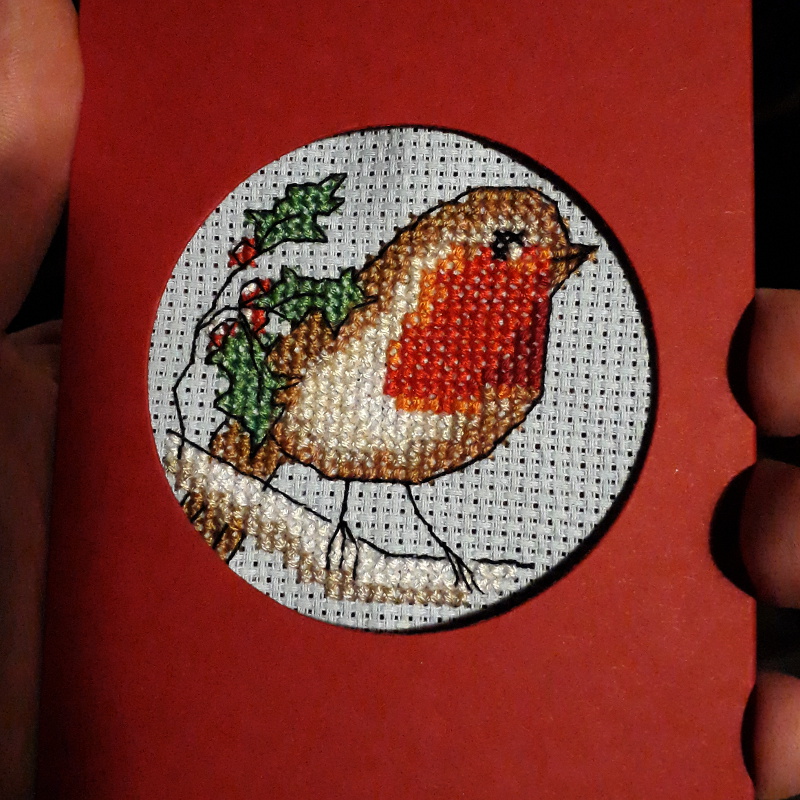I was inspired by a random comment I read on Twitter to attempt a modern-day update of the classic inter-war Christmas fable The Box Of Delights. This is the result, or at least as much as I have written so far. Great apologies are due to the ghost of John Masefield, I suspect.
It was a dreary, grey afternoon, the winter solstice approaching, and the last day of the school term. Kay Herald sloped home, uniform tie already off, with a spring in their step and half a smile on their face. In one sense, the Christmas holiday meant a fortnight of boredom with little to do and nothing happening. Kay was too old now for all of the magic to be real, and felt almost ashamed they once had genuinely believed in it. Nevertheless, in their heart they still knew it was a magical time, their family following the same rituals every year, putting up the same tree as always and hanging the same trimmings upon it, the same tinsel on the mantelpiece, just as when Kay had been a baby. It was still the time to light a log in the grate, turn down the lights, and hang stockings on the ends of their beds knowing they would be full of presents in the morning, and Kay still looked forward to that however much they grew cynical about adults, about school, about every aspect of growing up, getting older, and losing all the excitement and freshness of childhood.
Kay wondered, as they wandered, what it had been like back in the days of boarding schools, when you didn’t see your parents every day, when seeing them for Christmas must have been fresh and new and exciting. Spending your days in a strange, cloistered world full of its own curious traditions, jargon and slang; your own little barracks civilisation almost entirely unlike real life. And then, to be wrenched from it and put on a train with a steamer-trunk, on your own, sent back and expected to make your own way, changing at remote railway junctions and not getting fleeced by the other travellers. Back home to some strange adults you hardly knew and who didn’t really want you around the place. Or maybe, Back In Those Days, your parents would have been away in The Colonies and you’d be sent to live with a crumbling great-grandmother in a haunted manor house. Christmas with some friendly 17th-century ghosts sounds far more exciting than just being at home and not having to go to school. And the whole idea of finding your way across half the country on the train on your own, when Kay was barely allowed to walk by themselves any further from home than school.
They walked down a narrow, steep path between a railway embankment on one side and allotments on the other, a shortcut between two parts of the city which would have been a long way apart via wider roads. At the bottom, where the path met a road in a triangle, stood two people. One tall, thin and leaning on a lamppost; the other shorter, fatter, looking at their phone. Kay gave them a wide berth, as you do with strangers on the street, but nevertheless the thin one looked up as they passed. “Why hello there,” he said, in a soft, neutral, generic-American accent.”
“Yeah, hi,” said Kay, warily, looking at them but still gently moving.
“We don’t want to alarm you,” said the thin man. He was thin in many ways, with thin lips and thinning ginger hair. His ears twitched, and almost seemed pointed. “We’re not from around here; you might tell! We’ve gotten ourselves a little muddled here.”
“Hey,” said the other one: a woman with long curly dark hair and a chubby, dimpled face. “We didn’t want to startle you. We’re just like strangers here.”
“We thought you looked like a guy who, well, knows the neighborhood,” said the thin man. “We’re just a bit lost here. Annie here can’t get a signal.”
“Yeah,” said Kay, “the phone signals round here are pretty poor, and the maps get confused too.” They looked at the two Americans: they looked almost like some sort of cultists or missionaries, but they weren’t wearing the sharp suits of the Mormons who stood trying to hand out their own Bibles by the park. Instead they were in some sort of strange black robes which changed as they turned, looking loose at one moment and tight-fitting the next. When the man stood straight it looked like a shiny trenchcoat; when he lounged, like a matt black surplice. Each also wore some sort of white dogcollar around their bare necks, which did nothing for the overall strangeness of their outfits.
“We’re trying to get over to Downley,” said the woman, Annie. “Is it up the path, or down this road?”
“And is that there path safe for strangers like us?” added the ginger-haired man. “You know, not knowing the lay of the land like you do.”
“Yeah,” said Kay, shrugging. They had never had any problems on that path, but they had never tried to go down it, unlit, too late on a dark afternoon.
“Well that sure is good to know,” said the man, with Annie nodding along. “We’re neighborly folks ourselves, we don’t want to cause any trouble now.”
“We sure don’t, that’s right!” the woman said. “Do you look out for your neighbor?”
“I guess,” said Kay. They lived in an end-terrace, and the house next door had been empty for a while. Like many houses in the neighbourhood, it had had a “For Sale” sign up for all of a couple of days before it turned into a “Sold” sign, but then the sale itself had presumably been tied up in months of negotiations on the exact price and state of the crumbling Victorian place, the “Sold” sign had stayed in place and no new neighbours had arrived.
“Well you certainly should do,” said the thin man. “Keep an eye on him, and let us know how he is. Good to meet you, Kay.”
“Whatever,” said Kay, and turned to walk away. After a few steps they looked back over their shoulder, just to make sure. Indeed, the two Americans had disappeared into the darkening afternoon. Kay heard a rustle as some animal ran through the bushes alongside the railway line, and suddenly thought: how did they know my name? They shivered slightly, and started walking slightly faster home.
As it turned out, Kay was going to have a new neighbour sooner than they had realised. A removal van with a London address on the side was blocking the street outside their home, its hazard lights flashing like an invulnerability spell and burly men lifting furniture out of it. The front door of the empty house next to Kay’s was open, and in the front garden a man was rocking and tugging on the Sold sign as if it were a loose tooth. Kay made the mistake of pausing to look at the operation as they hunted for their house-key, for of course the man stood up and raised a hand in greeting. “Good evening, my neighbourhood friend,” he said, in a deep, warm and curious voice.
“Hey,” said Kay, wondering if this conversation would be as strange and threatening as the last. “Moving in?”
“How very observant, young fellow,” said the man, in a friendly voice which diluted some of the pomposity of his words. “Moving on and moving in, indeed. Doctor Redwald Johnson, pleased to meet you and so on and so forth. And may I ask, so as not to offend, but are you a he-creature or a she-creature or a they-creature?”
“A they-creature,” they said. “Kay. Thanks for asking though.”
“Lovely to meet you, Kay,” said the man. His olive-complexioned face was bearded, and it hid his age with great success. His head seemed shaved bald, but was largely covered by an oversized and worn flat cap. His clothes seemed well-worn but carefully-chosen, an eclectic mixture of fabrics and stuffs, with waistcoat, cravat not matching shirt, moleskin trousers tucked into worn-out riding boots. With pierced ears, the overall air was of some sort of aging hipster trying not to age. If you had to guess his profession, you might think off-duty chef, or artisan baker, or development brewer at a tiny and exclusive microbrewery. In short, exactly the sort of man you would expect to move into Kay Herald’s slowly-gentrifying inner city neighbourhood.
“And you, Doctor Redwood,” said Kay.
“Redwald,” said the man. “Redwald Johnson, for all my sins. I hope this is a good town to be.”
“It’s always been fine for me,” said Kay. “Mostly anyway,” they added, remembering the slightly strange American cultists. “I’ll see you around.”
“I’m sure you will,” said Redwald Johnson. “And we should better be going. My house needs to be rearranged, and I am sure you have a great deal of holiday things to be doing. Katsu curry waits for nobody.”
“The sign’s got a number on it,” said Kay, “to come and collect it after you move in. On the back. Anyway, see you.” They opened the door, and walked into their house.
“What’s for dinner?” shouted Kay, as they shuffled up the stairs to their bedroom. There was a sound of bustling and clattering from the kitchen, but no answer. Kay kicked their schoolbag under their bed, quickly changed into clothes without any school crests or logos on, and went back down again.
“You know I don’t shout halfway across the house,” said Kay’s mum. “I’m not shouting when you can come in here and ask.”
“Sorry mum,” said Kay. “What’s for dinner?”
“Katsu curry,” she replied, “as you like it and as it’s your last day of term. I thought I’d better do something to make you sit and have dinner with the rest of us.”
“Ooh, thanks,” said Kay. “What do you think of that guy then?”
“What guy?”
“The new guy next door.”
“There’s a new guy next door? I thought I heard a lot of noise, but I just thought it was more builders.”
“I thought you must have talked to him,” said Kay. “He’s ok. A bit strange, but not as weird as the Americans who stopped me in the street earlier.”
“What did they want?” said Kay’s mum, breaking blocks of curry sauce into a pan.
“I dunno. Just directions? I think. It was all a bit weird. They knew my name too.”
“You probably just had your bag open,” said their mum, “and saw it on one of your books.”
“I guess,” said Kay, unconvinced.
Kay’s dad exploded into the room, a bundle of sudden energy. “Have you heard the news?!” he interrupted, his face in a beaming smile.
“We were having a conversation in here, you know,” said Kay’s mum, “before you burst in here. I’m sure it’s not important.”
“Andata are going to open a big new European office right in the city centre! Jim Bright himself is going to have an office there! Just over the road from where my office is.”
“Not that you ever go there any more,” said Kay’s mum. “Not important. How is that going to have any effect on us?”
Kay had heard of Jim Bright: one of a handful of men who lived on the west coast of America who could, if you believed the stories, pay to feed everyone in the world twice over and still have enough money to live on for any sort of forseeable lifetime. His first few million dollars had been generated from a piece of software that seemed deceptively simple but had taken geniuses to create: it tracked all the music you listened to, and then sold you the music you didn’t know you wanted to hear and the machines to listen to it on. At first Jim Bright’s recommendations took control of the music charts until they were effectively obsolete; after that, his company, or rather his subtle software engines, began to compose new, tailored music especially for each listener, targeted to satisfy, to heighten or dampen any of your own personal emotions. It was either insanely popular or entirely despised, depending on your point of view. His corporation, Andata, had branched out and now earned its billions from renting out its computer power to anybody who needed it.
“You never know!” said Dad, almost bouncing up and down with excitement. “What if I’m buying a coffee to take to the office, and Jim Bright is in there buying one too? We might even get to have a chat!”
“Jim Bright,” Kay’s mum replied sensibly, “has people to go out and get coffees for him. And besides, it’s not as if he’ll ever actually be there. It’ll just be full of sales people and accounts people and nothing you’d actually be interested in.”
“No, really,” said Dad, unwilling to give his hopes up, “he’s going to have an office here himself and everything! Look!” He thrust his phone screen in front of them, and pressed play on a news clip.
Even on the screen he looked like a tall man, bald, with a deeply-lined face and a wise smile. “…ommunity,” he was saying, “is really at the heart of everything we do here at Andata. We’re not faceless scientists. We’re not Silicon Valley wizards in our castles. We’re all about community. And this city … you love tech! You’ve got startups here, you’ve really gotten going in the last few years, you’re full of smart passionate people. And I just want to build on that.”
“But why does this project matter so much to you, Jim?” said a softball interviewer, off-camera.
“England … it’s always meant so much to me. I grew up here,” he said, and as he said it Kay realised his American accent was really just a few superficial vowels on top of a deeper more European stratum. “You guys all think of me of some Seattle guy, some West Coast technologist. And, sure, I’ve lived there a long time, in one sense I guess that does feel like home to me. But England … I grew up there, y’know? I grew up in Herefordshire, right in the depths of the countryside, in this little old boarding school run by monks, where our grounds were in England and Wales was just over the hedge. Now, I learned everything I know about math, and AI, and tech, at college in the US, but I learned everything I know about people, and history, and the land, from Reverend Doctor Boddledale’s strange little boarding school. And that’s made me who I am today. And that’s—” and at this point his voice grew deeper and all the American vowels and vocabulary suddenly faded away from it, “—why I’m back.”
“See!” said Dad, fizzing with excitement. “Jim Bright’s going to be right in the city centre! You never know, I could be working at Andata this time next year!”
“This year, though,” said Kay’s mum firmly, “there’s something else I need to tell you both. Your Jones cousins are going to have to come and stay for Christmas. Auntie Susan is back in hospital again with her post-viral thing, so better they come here and can spend it with family. It’ll be better than last year if nothing else. At least they’ve all had the vaccine.”
“It’s going to be a squash, isn’t it?” said Kay. There were four of the Joneses, quite a squeeze in a small terraced house.
“Two in the spare room and two in the front room,” said Kay’s mum. “Or one in your room maybe. I don’t know. I don’t really care. I just want to make sure they have a better Christmas this year.”
Later on in the evening, the dreary clouds cleared. The temperature dropped, the stars came out, and Kay went offline and down to the bottom of the garden. Being in a city the views were not great, rather orange-tinged from light pollution, and Kay’s garden was in something of a dip; but nevertheless Kay would set up their telescope and look up at the planets and stars. The garden was long, thing, and sloped steeply down away from the house into a little nameless valley. Once it had been the site of a paupers’ burial ground, and Kay was always slightly nervous about probing the ground at the bottom of the garden lest they uncover a skull or a long-bone. Down the bottom of the garden was quiet, though, aside from the occasional screech of a fox, and well away from the parents. Tonight Kay leaned back in their deckchair, the telescope set up on a picnic table alongside but not being used. The big December meteor shower had been just a week ago, and there were still maybe the odd one or two to be seen. Kay leaned back, looked up at the sky and as their pupils dilated more and more stars came into view. Aries to the south, Andromeda above it, Perseus and Orion following behind.
“Why hello, young Kay,” said a voice. Kay sat up, sharply. “I’m sorry there. I did not at all mean to startle you. It is I, Redwald Johnson, conjurer and technologist, on the other side of your garden fence.”
“Who isn’t a technologist these days,” said Kay. “Dad’s one. You’re one. Everyone is in technology now. I just wish I could go back and be a hedge-witch or something.”
“Ah, the very same thing though,” said Redwald Johnson. “The astronomers and the witches and the alchemists: technology, all of us. Every year in its own way, doing our little thing to spread magic and enjoyment into the world. I didn’t mean to alarm you. I enjoy the company of a fellow-traveller among the stars, in an observational manner of speaking, and I am also wary we may be able to help each other, when we both need it.”
Kay leaned their head back again, and looked up at the stars. Redwald Johnson’s voice from over the garden fence was rich and luxurious, like buttered crumpets with jam.
“I feel I must be on the same side,” the man continued, “of anyone who enjoys the shows the heavens can put on for us. You were expecting meteors, I take it?”
“There were a lot last week, at the peak,” said Kay, “and a good few since. Might still be some in the sky tonight, especially later.”
“I fancy,” he said, “we may well have a show. And look, one is early!” A lazy, fat line of light scored its way across the sky before fading away. “Slow things, these Geminids,” he continued. “Not flashing across the sky like arrows as the Perseids do.”
“The long ones are always earlier in the night,” said Kay. “They have shorter trails later as their origin gets higher in the sky.”
“Burning up and dying away as soon as they are noticed,” Redwald Johnson replied. “And they have only been in the sky for a few decades, these winter marvels. Newcomers. Your Babylonian sky-watcher would be baffled by them, or any other of us astronomers from Pagan days. Now the rest of the sky, all those distant lights, their lives are far longer than yours and even mine. They were here when I was young and might be here when we are gone. Which are you drawn to?”
“The Pleiades,” said Kay. The Pleiades had always been their first love in the sky.
“Ah, the seven sisters,” said Redwald Johnson. “Although I am sure that telescope of yours can pick out many many more. Such a tragic story, those women. Watch.” And Kay watched, and could see, not just six faint stars, but seven bright ones, and each of the seven stars was a woman, sitting in the sky, tears rolling down her face. “Mourning their father,” Redwald Johnson said, “and always running.” And behind them came a great hunter, his feet on the rooftops, his sword at his belt, an animal-skin draped over his shoulders.
“Orion!” whispered Kay.
“Orion himself,” said Redwald Johnson. “And he hunts, as he has always hunted. At least as far back as men can remember.” Orion slashed out with his sword, at all the creatures around him: a hare at his feet, a horse approaching, a great bull at his shoulder. The horse turned its head, and Kay saw a slender, spiralling horn glinting in the starlight.
“Unicorn!” said Kay. A dog below the hunter’s feet darted from between the unicorn’s hooves, and worried at the hare; its eyes were so gleaming bright, Kay knew it must be the Great Dog of the sky. “They’re going to fight. It’s going to turn into carnage.”
“These stars are all fixed in the past,” said the man. “Tomorrow night, they will be back in their appointed place. That is their joy and their doom. They have eternal life, and the price of it is higher than you might think. But you are lucky, to see this show, for many look at the stars at night and are not granted this display.” The unicorn whinnied, so loud Kay thought it must wake the city and the dead. It shook its head at Orion the hunter, and Kay saw the desperation in its eyes. Orion drew his sword, and its ancient bronze blade was a sparkling host of new worlds continually forming. His figure blurred and faded, and Kay saw the millions and billions of years of stars and galaxies and nebulas, all in front of their eyes, stretching away beyond human sight into the shadowy world of the moment of the universe’s birth.
“Are they always there?” said Kay. “I mean … are the constellations real? Not just stars?”
“They are stars, and they are real, together,” came the reply. “And not all of them are the constellations you might expect. Greece and Babylon did not have a monopoly on wisdom. They fight out this play every night, for those who can see it, for not many can. But at the same time, they are stars, they are vast, and they are unimaginably remote and from times past. Just like myself, you could say.”
“I wish I could see them again,” said Kay. “I wish I could always see them.”
“It will happen again,” said Redwald Johnson, “whether you see them or not. They are eternal, unlike the meteors. And unlike me. Draw your sword at you and me, and neither of us will be here upon the next night. The days of setting heros among the stars have ended.”
“I’m not sure anyone here has a sword,” said Kay, thinking at the same time that some people in the city probably did.
“Ah, well,” said the old man. “The Wolves are Running. They’ve been Running before, as you may well know. They’ve run at me before, and sometimes they’ve run me very close. And now they’re Running again and they’re still after me.”
“We have foxes,” said Kay, “but we don’t have wolves.”
“These Wolves are not always in the shape of wolves. Sometimes, they are, and sometimes, they are not. They might be here already; I think they may be. We must be on our guard. Will you help me, when they come running for me?”
“I’ll do whatever I can,” said Kay, unsure if they really meant it.
“Why thank you,” said Redwald Johnson, “it may be a great help. I fear it is close to midnight, and that is often their hour, so I feel we should head into the safety of home. Goodnight, Kay Herald. And remember, the Wolves are Running.”
“Goodnight,” said Kay. Overhead a meteor flashed, and disappeared.
*Part Two of this story is here.*
Keyword noise: Not The Box Of Delights, Christmas, Yuletide, fiction, stories.


 Home
Home


